Medical Transcription Services vs. Speech Recognition Software: Which One Is Better For Your Practice?
Nov 21, 2019 | Jonathan Maisel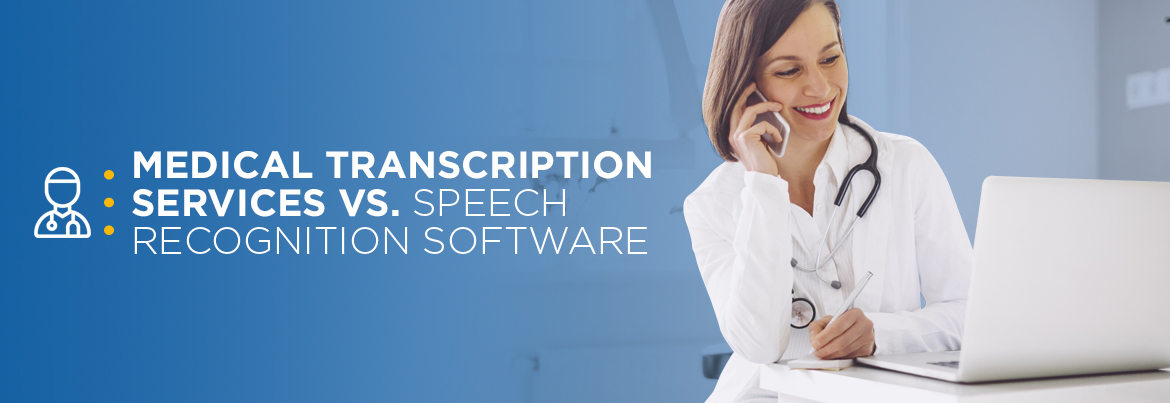 Today’s physicians are faced with more responsibilities and regulatory challenges than ever before. With the implementation of stricter quality standards under the Merit-based Incentive Payment System (MIPS), doctors need their notes to be more complete and more accurate to receive the financial incentives that keep a practice profitable. There are essentially three options for creating documentation — manually writing up notes, speech recognition software and medical transcription. With the move to electronic health records, manually writing notes is becoming an outdated and inefficient method of documentation. So more physicians are turning to either speech recognition software or medical transcription services for their clinical documentation needs.
Today’s physicians are faced with more responsibilities and regulatory challenges than ever before. With the implementation of stricter quality standards under the Merit-based Incentive Payment System (MIPS), doctors need their notes to be more complete and more accurate to receive the financial incentives that keep a practice profitable. There are essentially three options for creating documentation — manually writing up notes, speech recognition software and medical transcription. With the move to electronic health records, manually writing notes is becoming an outdated and inefficient method of documentation. So more physicians are turning to either speech recognition software or medical transcription services for their clinical documentation needs.
What Are The Benefits of Speech Recognition Software?
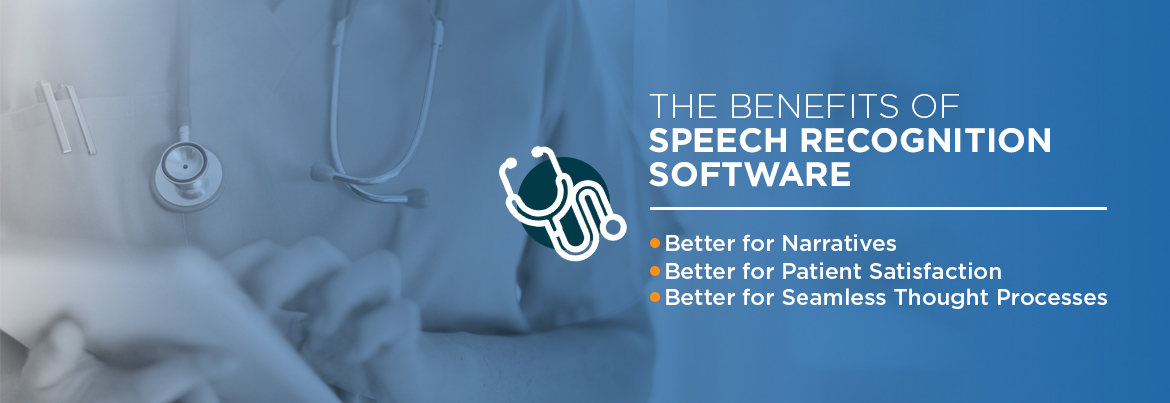
Speech recognition software allows physicians to speak into a recording device, which feeds the information into the software. The software then compiles the physician’s speech into written text to be edited and reviewed. There is a technical difference between voice recognition and speech recognition — voice recognition identifies the person speaking while the speech recognition identifies the words spoken. However, the terms are often used interchangeably.
There are several advantages of speech recognition software for clinicians that make it a clear winner over manual documentation methods.
1. Better for Narratives
While electronic health record (EHR) software has increased the amount of information doctors are expected to include in their notes, manual documentation strips the notes of nuances that can help improve outcomes. Simple and straightforward conditions like heartburn can easily be documented with the basic question lists or algorithms in a barebones EHR, but more complicated conditions often involve psychosocial symptoms that are just as important.
If a patient has a complicated history, a lot can be lost in translation when clicking around in an EHR. As such, being able to speak directly about a patient’s experiences creates richer data and more comprehensive problem lists.
2. Better for Patient Satisfaction
If given the choice between talking to a doctor who is clicking away at a keyboard and one who dictates the history and assessment during the appointment, almost all patients will choose the latter. When the patient can hear what the doctor is putting into the chart, they likely feel the doctor is paying more attention and they are being taken care of better.
Patient satisfaction also affects engagement in treatment. If a patient feels that what they’re saying is more fully encapsulated in their records, they’re more likely to share key information that can improve their outcomes.
3. Better for Seamless Thought Processes
Learning to input notes using templates and mouse clicks requires that clinicians train their minds to work a certain way. While many physicians can adopt this way of thinking, many would also agree that it can be restrictive. Speech recognition software allows doctors to think out loud, which can often lead to unique insights that wouldn’t come to light with manual entry.
For many doctors, it comes down to time. Rather than thinking within the confines of manual data entry, they can let their natural thought process guide the notes, which is often much faster.
What Are The Limitations of Speech Recognition Software?
Although speech recognition software presents some distinct advantages over traditional documentation creation, there are ultimately too many limitations that keep it from being the most effective way to create notes.
1. Formatting Issues
For notes to be clear and comprehensible, they need to be formatted correctly. That means proper punctuation, paragraph breaks, and bulleted lists, at the very least. When using speech recognition software, physicians must either verbally speak commands for each and every piece of punctuation or edit for formatting as they type.
If they opt to insert punctuation and other formatting verbally, those extra commands can easily throw off the entire thought process, negating the benefit of speaking aloud. The thought process can also be equally disturbed if the clinician decides to format with a keyboard while speaking aloud.
2. Extensive Training Time
Speech recognition software claims to be able to handle accents, but the veracity of this claim varies depending on the software and the speaker’s depth of accent. Speech recognition software can eventually be trained to recognize accented speech, but the process for correcting the software and attuning it to specific accents can take many hours that busy clinicians simply don’t have to spare.
Even without a perceivable accent, each physician needs to spend at least some time with the speech recognition software to train it for accurate use. In combination with the addition of unique words or abbreviations, clinicians can use up a frustrating amount of time adapting the software to their particular needs.
3. Speech Recognition Lacks Accuracy
The problem that most plagues speech recognition software is an abundance of errors. A recent study published in JAMA identified and analyzed errors of notes dictated with speech recognition software by 144 different physicians. Across all documentation, the study discovered an error rate of 7.4%. A significant amount of those errors involved clinical information that could affect treatment decisions and outcomes for the patients.
Additionally, insurance companies will pounce on any documentation containing errors, causing issues with reimbursement that can lead to delays in payouts or being denied reimbursement altogether. Some of the reasons speech recognition software can fail include:
- Words pronounced with an accent
- Speaking too quickly
- Speaking too loudly
- Speaking too quietly
- Background noise
The number of factors that can cause complications and require correction with speech recognition software can be frustrating enough to drive physicians and administrators in search of a better option.
What Are The Benefits of Medical Transcription Services?
Outsourcing your practice’s documentation to a reputable medical transcription service is the best way to improve the quality of physician notes while easing the burden of documentation. With a medical transcription service, doctors still get the benefits of dictation without the challenges of speech recognition software.
The recorded audio is sent to skilled transcriptionists who will take care of all of the little things, like formatting, that can eat up a doctor’s time if they’re using speech recognition software. Here are just a few of the benefits your practice can expect.
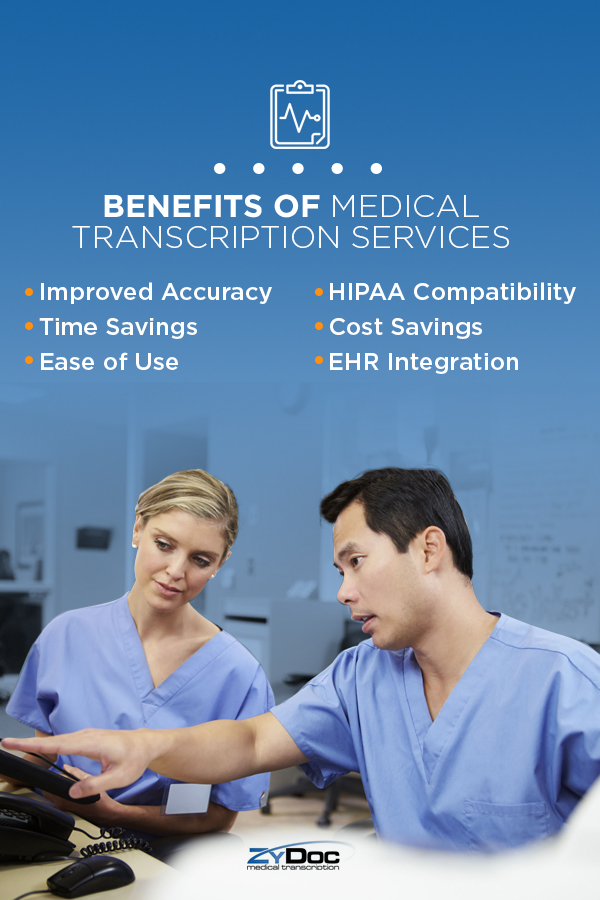
1. Improved Accuracy
The disturbingly high error rate of speech recognition software is actually easily correctable with the implementation of transcriptionist review. The JAMA study saw error rates free fall to just 0.4% when the documentation was reviewed by a transcriptionist.
With speech recognition software, the doctor must complete a review. Anyone who has tried to edit their own work knows that it’s easy to let mistakes fall through the cracks, but physicians can’t afford to create documentation with even a few mistakes. There’s no replacing the human touch when it comes to proofing critical documentation, and medical transcription provides this.
With improved accuracy comes less risk of malpractice suits and better protection against audits, both benefits that can deliver better peace of mind to practices of all sizes and specialties.
2. Time Savings
A doctor’s time is very valuable, and saving even a few minutes per appointment adds up to many hours of treating more patients over time. Although speech recognition software claims to be much faster than manual note-taking, it doesn’t always turn out that way when doctors have to spend time formatting and editing their documentation every time they take notes.
With medical transcription services, doctors simply record their notes, send them to the transcription service and move on to seeing their next patient.
3. Ease of Use
Training speech recognition software can be tedious as well as frustrating for physicians. Additionally, this type of software often comes with a daunting learning curve that can frequently lead to lost time and potential mistakes. With medical transcription, doctors can just speak into the recorder without having to do any training of algorithms. The best services offer multiple ways to dictate, including through proprietary apps, specialized recording devices or even calls to a traditional phone line.
4. HIPAA Compliant
All physicians and medical professionals are familiar with the stringent requirements of the Health Insurance Portability and Accountability Act (HIPAA), but with the multitude of speech recognition software options, not everyone realizes that these programs aren’t necessarily HIPAA-compliant.
Reputable medical transcription services understand the crucial importance of data security and require all employees and business associates to complete comprehensive training on HIPAA and security best practices.
5. Cost Savings
Outsourcing medical transcription saves money on several fronts. For one, you’re not paying a doctor full salary for performing mundane administrative tasks. The more time a doctor saves thanks to transcription, the more value they can add to the practice by performing core duties and patient care.
Outsourcing also removes the cost burden of hiring someone to do transcription. That course of action will cost money in terms of recruiting, salary, training and benefits. It also comes with no guarantee that your investment will pay off. Medical transcription services are staffed with highly vetted and trained transcriptionists who will reliably deliver accurate, timely results every time.
6. EHR Integration
One of the largest regulatory pushes in the healthcare industry is toward complete interoperability. Speech recognition software usually has a limited ability to interface with EHRs as a consequence of the more manual setup. Medical transcription services, on the other hand, are known for being compatible with multiple EHRs.
The most robust transcription services integrate with EHRs directly, populating charts with the appropriate information as soon as the transcription is complete. The seamless and HIPAA-compliant transfer of completed transcripts to your practice’s EHR will reduce stress and contribute to time savings.
Medical Transcription Services vs. Speech Recognition Software
Medical transcription is experiencing rapid evolution that’s making speech recognition software all but obsolete. Hospitals are transitioning to outsourced medical transcription at a rapid clip, with rates expected to double by 2020. The benefits are clear, and there are no drawbacks to speak of.
While speech recognition software was revolutionary when it was first introduced, it has been replaced by something newer and better — transcription services. As these services continue to become more sophisticated and streamlined, the cost advantage of using the older speech recognition software has completely evaporated. There is no good reason to use a clunky piece of labor-intensive software when an affordable service can do the same job more accurately and with no hassle required.
There’s also the matter of burnout — a serious condition that affects more than 40% of physicians. Burnout can cause the quality of care to plummet and lead to costly mistakes. In many cases, the frustration associated with the ins and outs of speech recognition software can contribute to this ongoing phenomenon. Medical transcription allow physicians to spend more time seeing patients and less time on documentation tasks, thereby reducing physician burnout.
What Are the Hallmarks of an Excellent Medical Transcription Service?
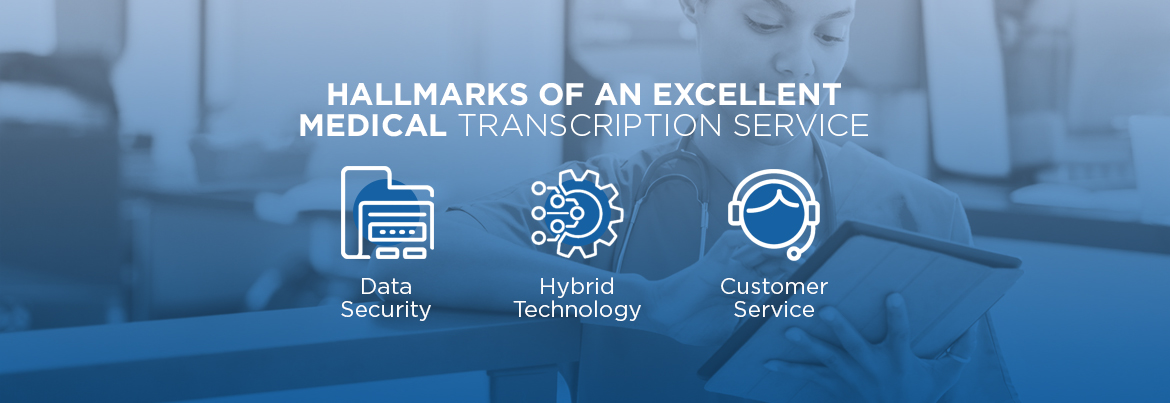
There are hundreds of medical transcription services vying for your business, but not all are created equal. For transcription services to be a smart choice for your practice, you need to choose a company that checks all the boxes for safety, efficiency and service. ZyDoc Medical Transcription is a recognized industry leader for the following reasons:
1. HIPAA Security
If you want to avoid the headache, fines and reputation loss that accompany a data breach, you need to work with a company that takes HIPAA security as seriously as you do. ZyDoc uses data encryption throughout their systems and stores your patient information in redundant, HIPAA-compliant cloud servers.
Don’t take risks with your patients’ private information. Be sure to ask prospective companies how they will responsibly handle and protect your data.
2. Award-Winning Customer Service
Medical transcription services are easy to use and require very minimal training, but customer service is still a core element in a successful business relationship. ZyDoc’s customer service was rated number one in customer service and support by more than 2,900 practitioners in 2018 according to Black Book Research. We stand by our service and by your practice.
3. Prompt Turnaround
Our spirit of service shows through in our turnaround times, too. With some companies, you have to wait one or two days at a minimum to see the results of a physician dictation. With ZyDoc, upto 90% of your jobs will be turned around in two hours. The difference is stark, and it can have a significant positive impact on workflow and reimbursement.
Is ZyDoc Medical Transcription Right For You?
Physician burnout due to increased burdens of documentation is very real and very detrimental to a practice of any size. Removing the need to input notes manually or struggle with the disadvantages of speech recognition software can make a noticeable impact on your physicians’ quality of life and quality of care for patients. ZyDoc’s innovative, cloud-based medical transcription services can be the change you need to streamline your workflow.
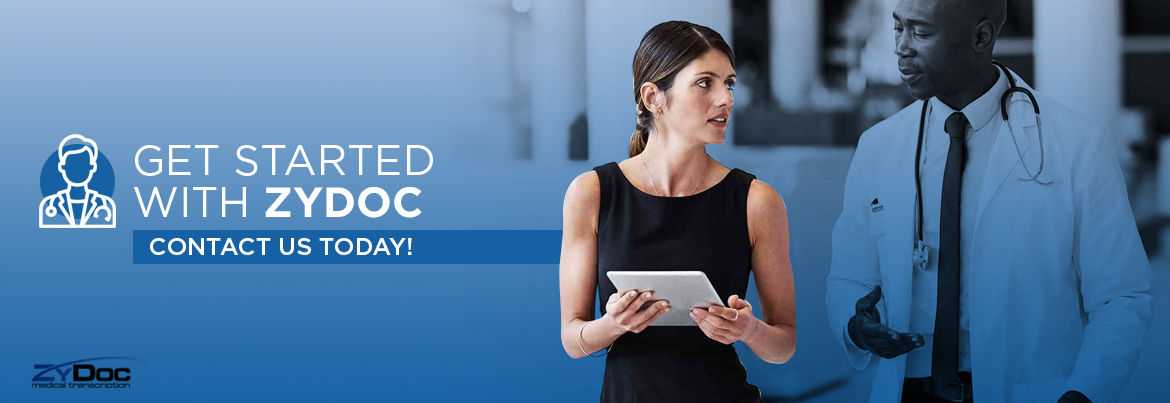
To learn more about how the service works and how it can benefit your practice, get in touch with ZyDoc. You can find out more about our transparent plans and pricing online or request a 14-day free trial to see the benefits of medical transcription services for yourself.
